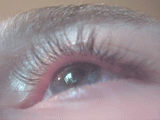User:Mr. Ibrahem/Blepharospasm
| Blepharospasm | |
|---|---|
| Other names | Benign essential blepharospasm (BEB), eye dystonia, eye twitching, eye spasm |
 | |
| Benign fasciculation syndrome of the upper eyelid in a 19-year-old male. It subsided after several days. | |
| Pronunciation | |
| Specialty | Neurology, ophthalmology |
| Usual onset | Gradual[1] |
| Causes | Unknown[2] |
| Diagnostic method | Based on the symptoms[2] |
| Differential diagnosis | Meige syndrome, Bell's palsy, hemifacial spasm[2] |
| Treatment | Botulinum toxin, surgery[1] |
| Frequency | 1 in 20,000 people[2] |
Blepharospasm is eyelid movement, such as blinding or twitching, that is not controllable.[1] Often it is gradual in onset and in severe cases may result in closure of the eye.[1] Both eyes are generally affected.[2] It may be short or long-term in duration.[1] It may be associated with twitching of other parts of the face.[1]
The cause in unknown.[2] Risk factors include family history and it is occasionally associated with eye trauma.[1][2] It may also occur as part of certain conditions such as tardive dyskinesia, Wilson disease, and parkinsonism.[2] Emotional stress, tiredness, or bright lights may worsen the condition.[2] It is a type of focal dystonia.[2] Diagnosis is based on the symptoms.[2]
While there is no cure, botulinum toxin injections may help temporarily.[1][3] Other measures that may help include getting sufficient sleeping and lowering caffeine use.[1] Surgery to remove the eyelid muscle may occasionally be carried out.[1]
Blepharospasm affected about one in 20,000 people in the United States.[2] Women are more commonly affected than men.[2] The typical age of onset is 40 to 60 years old.[1] The condition has been described since at least the 1870s.[4]
References[edit]
- ^ a b c d e f g h i j k l "Blepharospasm | National Eye Institute". www.nei.nih.gov. Archived from the original on 9 April 2019. Retrieved 24 January 2022.
- ^ a b c d e f g h i j k l m n "Benign Essential Blepharospasm". NORD (National Organization for Rare Disorders). Archived from the original on 2020-05-17. Retrieved 2020-05-30.
- ^ Simpson, D. M.; Hallett, M.; Ashman, E. J.; Comella, C. L.; Green, M. W.; Gronseth, G. S.; Armstrong, M. J.; Gloss, D.; Potrebic, S.; Jankovic, J.; Karp, B. P.; Naumann, M.; So, Y. T.; Yablon, S. A. (18 April 2016). "Practice guideline update summary: Botulinum neurotoxin for the treatment of blepharospasm, cervical dystonia, adult spasticity, and headache: Report of the Guideline Development Subcommittee of the American Academy of Neurology". Neurology. 86 (19): 1818–26. doi:10.1212/WNL.0000000000002560. PMC 4862245. PMID 27164716.
- ^ Session, New Orleans Academy of Ophthalmology; Naugle, Thomas C.; Hesse, Richard J.; Fry, Constance L. (1995). Diagnosis and Management of Oculoplastic and Orbital Disorders: Proceedings of the 43rd Annual Symposium, New Orleans, LA, USA, February 18-20, 1994, Organized by the New Orleans Academy of Ophthalmology. Kugler Publications. p. 165. ISBN 978-90-6299-132-7. Archived from the original on 2022-01-24. Retrieved 2022-01-24.
